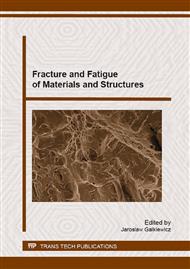[1]
Lipski A., Mroziński S., Approximate determination of a strain-controlled fatigue life curve for aluminum alloy sheets for aircraft structures. International Journal of Fatigue, 39 (2012) 2-7.
DOI: 10.1016/j.ijfatigue.2011.08.007
Google Scholar
[2]
Mroziński S., Lipski A., Method for processing of the results of low-cycle fatigue tests. Materials Science, 48 (2012) 83-88.
DOI: 10.1007/s11003-012-9475-0
Google Scholar
[3]
Mroziński S., Piotrowski M., About Fatigue Tests End Criterion In Elevated Temperatures. Key Engineering Materials, 598 (2014) 153-159.
DOI: 10.4028/www.scientific.net/kem.598.153
Google Scholar
[4]
Crupi V., Chiofalo G., Guglielmino E., Using Infrared Thermography in Low-Cycle Fatigue Studies of Welded Joints. Welding Journal, 89 (2010) 195-200.
Google Scholar
[5]
Naderi M., Khonsari M.M., An Experimental Approach to Low-Cycle Fatigue Damage Based on Thermodynamic Entropy. International Journal of Solids and Structures, 47 (2010) 875–80.
DOI: 10.1016/j.ijsolstr.2009.12.005
Google Scholar
[6]
Jiang L., Wang H., Liaw P.K., Brooks C.R., Klarstrom D.L., Temperature Evolution during Low-Cycle Fatigue of ULTIMET® Alloy: Experiment and Modeling. Mechanics of Materials, 36 (2004) 73–84.
DOI: 10.1016/s0167-6636(03)00032-2
Google Scholar
[7]
Jiang L., Wang H., Liaw P.K., Brooks C.R., Chen L., Klarstrom D. L., Temperature Evolution and Life Prediction in Fatigue of Superalloys. Metallurgical and Materials Transactions, A, 35 (2004) 839–48.
DOI: 10.1007/s11661-004-0010-2
Google Scholar
[8]
Mroziński S., Skocki R., Influence of temperature on the cyclic properties of martensitic cast steel. Materials Science Forum, 726 (2012) 150-155.
DOI: 10.4028/www.scientific.net/msf.726.150
Google Scholar
[9]
Mroziński S., Golanski G., Zielinska-Lipiec A., Fatigue Resistance of GX12CrMoVNbN9-1 Cast Steel after Ageing Process. Materials Science-Medziagotyra, 20 (2014) 396-402.
DOI: 10.5755/j01.ms.20.4.6077
Google Scholar
[10]
Golański G., Mechanical properties of the GX12CrMoVNbN91 (GP91) cast steel after different heat treatments. Materials Science, 48 (2012) 384-391.
DOI: 10.1007/s11003-012-9517-7
Google Scholar


